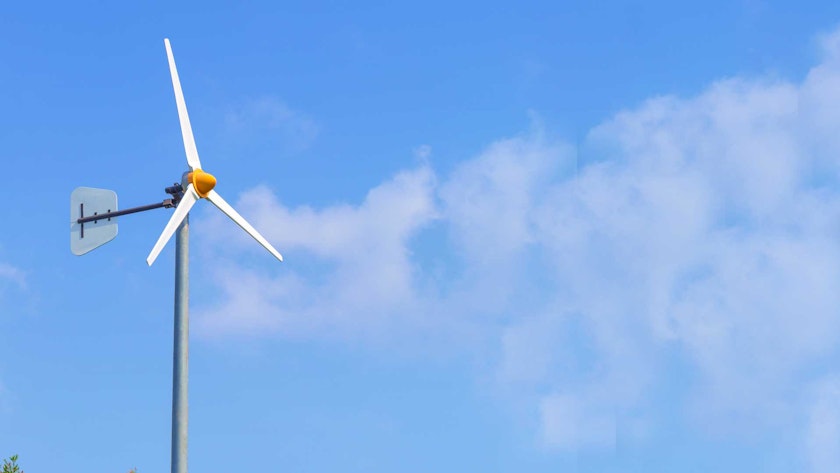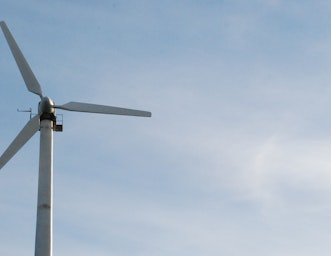
Joel Rawson explains what you should consider before installing a turbine at home and suggests ways to support wind power as part of a community, which could be better for the planet and your pocket.
As more households put in domestic batteries, interest is growing in small wind turbines. The thinking is to charge batteries during the winter, when solar PV contributes little. But before placing an order, there are some important things to think about.
Wind speed
The main question to ask is whether you have a windy enough location.
The power in a flow of wind is calculated from the wind speed raised to the power of three. This means that the power available in the wind rises exponentially as the wind speed increases.
To experience the higher wind speeds that will give a reasonable power output, a turbine must be high up and well away from obstacles such as buildings or trees. You generally need an average of more than 5m/s (metres per second). At CAT we only get that on the hills well above the site. Similarly, most houses won’t get very much wind outside of an occasional stormy spell.
There are online tools that give a rough estimate of local wind speeds, but they need to be used carefully.
For example, the Rensmart website hosts a map using the NOABL database of estimated wind speeds at heights of 10 metres or more. Speeds were modelled for flat terrain and give an average for a kilometre square. Therefore, although they can be an initial guide if a potential site is open and away from buildings, winds will be much reduced once you’re close to buildings or other obstacles, or nearer the ground.

Turbine size
Because the area of a circle is calculated using the square of the radius (A = π r2), increasing the length of rotor blades from 1 metre to 2 metres increases the area of wind being captured, and therefore also the power, to four times as much. A turbine with blades that are 10 times as long can capture 100 times as much wind. This shows the big economies of scale with wind power.
Smaller wind turbines (less than 1m rotor diameter) are not really designed for grid connected houses (see ‘getting connected’ below for more on this). The UK companies Marlec and Leading Edge make small turbines that can generate a few hundred watts of power in a strong wind. These are great for complementing solar panels in an off-grid setup, like on a boat or in a remote cottage.
There’s then a jump up to larger turbines that can generate a few kilowatts of power (similar to the peak output of a solar PV array) such as those from SD Turbines and Britwind. These can be grid connected and could make several thousand units of electricity per year. However, these are large machines, with a rotor that is several metres in diameter mounted on a high tower, so are not suitable for most homes.
The suppliers mentioned will be able to provide information, including a power curve and the energy yield for different average wind speeds, to help you decide if the turbine is right for your site. We can also provide further advice about the options for a specific site.
Buildings and roofs
Close to buildings, trees or other obstacles, the wind becomes turbulent and relatively weak. That means there is very little energy to harness in the first place, whatever the design of turbine.
The Warwick Wind Trials study found that sites on roofs and in urban areas performed badly – some turbines even consumed more energy than they produced! In comparison, a turbine on a good site (in an open area, on a high tower) would generate 20 to 30 times as much electricity as those on the poor sites in the study.
Even if a building-mounted turbine does occasionally receive some strong winds, the resulting vibrations can damage the structure. There are sometimes claims that a vertical axis rotor (which can look a bit like a large whisk) will capture turbulent winds. However, even if this can be done it would put more wear and tear on components, shortening the turbine’s life. Vertical axis wind turbines have been around a long time, and have tended to disappoint in practice.
Unhelpfully, some companies still make dubious claims about roof-mounted wind turbines – often linked to unusual designs they say will capture turbulent winds. They will commonly give very little data about actual real-world performance. For some turbines sold online, build quality and performance claims can be suspect. Plus they may well lack ongoing maintenance support within the UK. In contrast, the UK manufacturers mentioned above mainly sell horizontal axis (rotor type) machines that have been shown over time to perform well when properly sited. They should give good information upfront, plus ongoing support.
Getting connected
Aside from wind speed, sizing and siting considerations, it is important to note that connecting a wind turbine to most homes is not as simple as with solar PV. The management systems for lithium batteries sold for household use weren’t designed with small wind turbines in mind, so they won’t work properly together.
Connecting a turbine to an existing battery using a bespoke arrangement carries the expensive risk of invalidating warranties for the battery, inverter and possibly the wind turbine too. It can be possible to get a valid grid-connected setup, especially if starting from scratch, but the equipment needed won’t be cheap.
Beyond domestic wind – power in the community
When a small wind turbine is not feasible, there are other ways of purchasing or investing in wind power. Economies of scale mean that wind power is usually much more effective at a community level.
In 2003, CAT was involved with the installation of a community-owned wind turbine up on the hill above our site by Bro Dyfi Community Renewables (BDCR). A few years later, BDCR replaced an older experimental turbine operated by CAT with a second community-owned turbine. Because large scale wind power was rapidly becoming a mainstream technology, community ownership made much more sense than CAT operating a new turbine. We now use the electricity from these turbines indirectly via the local grid.
For more on community-scale options, see Community Energy England, Scotland, and Wales, who have more advice on setting up a project. There’s also the Energy Local model, where people effectively buy energy directly from local generators, and Ripple Energy, which combines a share offer with your energy tariff to give you a discount on bills.
About the author
Joel Rawson is CAT’s Information Officer, providing free and impartial advice on a wide range of topics related to sustainability. He first came to CAT to volunteer in 2001 and graduated with a CAT Postgraduate Diploma in 2013.
Support our work
Did you know that CAT is an educational charity? If you have found our Free Information Service useful, please consider becoming a member or making a donation to support our work.
Related Pages
Related events


Introduction to Renewables for Households
13th September 2025
Renewables for Households: Insulation
8th November 2025
Renewables for Households: Wind Turbines
10th January 2026EMAIL SIGN UP
Keep up to date with all the latest activities, events and online resources by signing up to our emails and following us on social media. And if you'd like to get involved and support our work, we'd love to welcome you as a CAT member.
